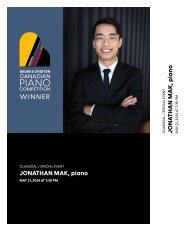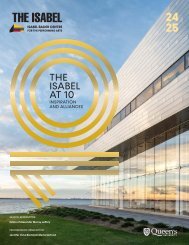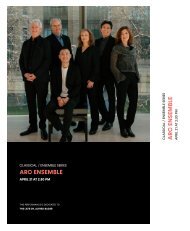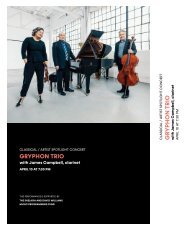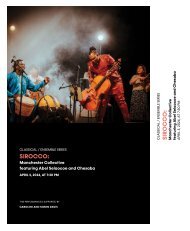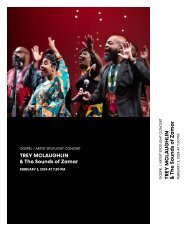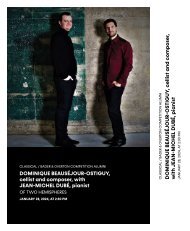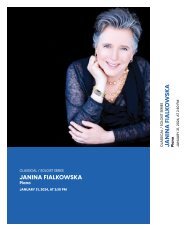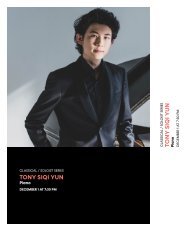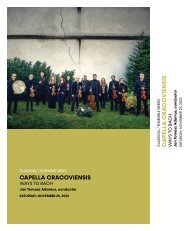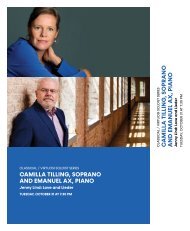Create successful ePaper yourself
Turn your PDF publications into a flip-book with our unique Google optimized e-Paper software.
CLASSICAL / ENSEMBLE SERIES<br />
ESCHER QUARTET<br />
<strong>with</strong> violist, Jordon <strong>Bak</strong><br />
MARCH <strong>16</strong>, <strong>2024</strong>, AT 7:30 PM<br />
CLASSICAL / ENSEMBLE SERIES<br />
ESCHER QUARTET<br />
<strong>with</strong> violist, Jordon <strong>Bak</strong><br />
MARCH <strong>16</strong>, <strong>2024</strong>, AT 7:30 PM
CLASSICAL / ENSEMBLE SERIES<br />
ESCHER QUARTET<br />
<strong>with</strong> violist, Jordon <strong>Bak</strong><br />
ESCHER QUARTET<br />
Adam Barnett-Hart, violin<br />
Brendan Speltz, violin<br />
Pierre Lapointe, <strong>viola</strong><br />
Brook Speltz, cello<br />
WITH<br />
Jordon <strong>Bak</strong>, <strong>viola</strong><br />
PROGRAM<br />
HAYDN<br />
String <strong>Quartet</strong> in D Major, Op. 64, No. 5, The Lark<br />
Allegro moderato<br />
Adagio cantabile<br />
Minuet: Allegretto<br />
Finale: Vivace<br />
JANÁČEK<br />
String <strong>Quartet</strong> No. 2, Intimate Letters<br />
Andante con moto — Allegro<br />
Adagio — Vivace<br />
Moderato — Adagio — Allegro<br />
Allegro — Andante — Adagio<br />
INTERMISSION<br />
DVOŘÁK<br />
String Quintet No. 3 in E Flat Major, Op. 97, American<br />
Allegro non tanto<br />
Allegro vivo — Un poco meno mosso<br />
Larghetto<br />
Finale: Allegro giusto
PROGRAM NOTES<br />
An accomplished violinist, composer Joseph<br />
Haydn (1732-1809) often played the first violin part<br />
in chamber ensembles for his own pleasure and<br />
enjoyment. This intimate understanding of what<br />
it means to sit in the first chair, is worth noting in<br />
the way that Haydn often gives the first violinist<br />
the important melodic material. In the case of the<br />
Op. 64, No. 5, <strong>Quartet</strong>, the first violin’s introduction<br />
of the opening movement’s main theme is said<br />
to characterize the work’s nickname, The Lark.<br />
As <strong>with</strong> many nicknames, though, once applied it<br />
is remarkable how appropriate they seem in the<br />
broader context—for example, the grace notes<br />
heard in the Minuet, could also be perceived as<br />
having a bird-like quality. Equally, the way the<br />
last movement flies off in just over two minutes,<br />
projects a soaring velocity that is just as apt.<br />
Czech composer Leoš Janáček (1854-1928) was<br />
born just 13 years after his compatriot, Antonin<br />
Dvořák (1841-1904), and he cited the older<br />
composer as an early influence, even dedicating<br />
some of his early compositions to Dvořák.<br />
However, Janáček’s Second String <strong>Quartet</strong>, one of<br />
the last works he composed, has a distinctive voice<br />
that seems far removed from Dvořák’s approach<br />
to tonality and form. This four-movement quartet,<br />
<strong>with</strong> its emphasis on introducing unexpected<br />
new ideas and colours at almost every turn is,<br />
by Janáček’s own explanation, representative of<br />
the ecstatic portrayal of a seventy-four-year-oldcomposer<br />
expressing his unbridled passion for a<br />
lover, 38 years his junior, and why he subtitled the<br />
work, “Intimate Letters.”<br />
At the age of fifty, Dvořák was appointed professor<br />
of composition at the Prague Conservatory, but<br />
just one year later he received an offer he really<br />
couldn’t refuse, becoming the Director of the<br />
National Conservatory of Music in New York<br />
City for a salary 25 times larger than his Prague<br />
stipend. Once in America, Dvořák was drawn to<br />
the originality of African/American spirituals and<br />
native Indigenous music, commenting specifically<br />
on how these musical traditions shared a common<br />
emphasis on repetitive melodic gestures and<br />
repeated rhythmic patterns. Dvořák even wrote<br />
articles encouraging American composers to use<br />
these sources as a foundation for a distinctive<br />
American style of composition.<br />
Shortly after arriving in in the United States,<br />
Dvořák accepted a New York Philharmonic<br />
commission for his Ninth Symphony, a work he<br />
subtitled, From the New World. This work so<br />
successfully captured the expressive flavour of the<br />
African/American spiritual in the slow movement’s<br />
theme, that 30 years later, words were added<br />
to the melody to create the spiritual-like song,<br />
“Goin’ Home.” This “new world” background bears<br />
heavily on today’s String Quintet, as it was one<br />
of three works given the subtitle, American—all<br />
of which were composed during the summer<br />
of 1893 while Dvořák was orchestrating the<br />
Ninth Symphony for its upcoming Carnegie Hall<br />
premiere. While there is an honest simplicity in the<br />
thematic material in these pieces, as always <strong>with</strong><br />
Dvořák, there is a spontaneity in the development<br />
of his musical ideas. This process is clearly on<br />
display in the Quintet’s slow movement that is<br />
structured as a set of five variations based on a<br />
double theme, the first half placed in the unusual<br />
string key of A flat minor, while the other half shifts<br />
to A flat major.<br />
©<strong>2024</strong> by John Burge for the Isabel<br />
ABOUT ESCHER QUARTET<br />
The <strong>Escher</strong> String <strong>Quartet</strong> has received acclaim for<br />
its profound musical insight and rare tonal beauty.<br />
A former BBC New Generation Artist and recipient<br />
of the Avery Fisher Career Grant, the quartet has<br />
performed at the BBC Proms at Cadogan Hall and<br />
is a regular guest at Wigmore Hall. In its home town<br />
of New York, the ensemble serves as season artists<br />
of the Chamber Music Society of Lincoln Center.<br />
The <strong>Escher</strong> <strong>Quartet</strong> has made a distinctive<br />
impression throughout Europe <strong>with</strong> recent<br />
debuts including the Amsterdam Concertgebouw,<br />
Berlin Konzerthaus, London’s Kings Place, Tel<br />
Aviv Museum of Art, and Auditorium du Louvre.<br />
The group has appeared at festivals such as the<br />
Heidelberg Spring Festival, Budapest’s Franz Liszt<br />
Academy, the Hong Kong International Chamber<br />
Music Festival, and the Perth International Arts<br />
Festival in Australia. Alongside its growing<br />
European profile, the <strong>Escher</strong> <strong>Quartet</strong> continues<br />
to flourish in its home country, performing at<br />
the Aspen Music Festival, Bravo! Vail, Santa Fe
Chamber Music Festival, Toronto Summer Music,<br />
Chamber Music San Francisco, Music@Menlo, and<br />
the Ravinia and Caramoor festivals.<br />
The 2022-2023 season saw the release of two<br />
albums including string quartets by Pierre Jalbert<br />
and the <strong>Escher</strong>’s studio recording of the complete<br />
Janáček quartets. Recordings of the complete<br />
Mendelssohn quartets and beloved romantic<br />
quartets of Dvořák, Borodin and Tchaikovsky were<br />
released on the BIS label in 2015-18 and received<br />
<strong>with</strong> the highest critical acclaim, <strong>with</strong> comments<br />
such as “...eloquent, full-blooded playing... The<br />
four players offer a beautiful blend of individuality<br />
and accord” (BBC Music Magazine).<br />
Beyond the concert hall, the <strong>Escher</strong> <strong>Quartet</strong> is<br />
proud to announce the creation of a not-for-profit<br />
organization, ESQYRE (<strong>Escher</strong> String <strong>Quartet</strong><br />
Youth Residency Education). ESQYRE’s mission is<br />
to provide a comprehensive educational program<br />
through music performance and instruction for<br />
people of all ages. In addition, the quartet has held<br />
faculty positions at Southern Methodist University<br />
in Dallas, TX and the University of Akron, OH.<br />
The <strong>Escher</strong> <strong>Quartet</strong> takes its name from the Dutch<br />
graphic artist M.C. <strong>Escher</strong>, inspired by <strong>Escher</strong>’s<br />
method of interplay between individual components<br />
working together to form a whole.<br />
ABOUT JORDAN BAK<br />
Award-winning Jamaican-American violist <strong>Jordan</strong><br />
<strong>Bak</strong> has achieved international acclaim as a<br />
trailblazing artist, praised for his radiant stage<br />
presence, dynamic interpretations, and fearless<br />
power. Critics have described him as “an exciting<br />
new voice in Classical performance” (I Care If You<br />
Listen), “a powerhouse musician, <strong>with</strong> a strong<br />
voice and compelling sound” (The Whole Note) and<br />
lauded his “haunting lyrical grace” (Gramophone).<br />
The 2021 YCAT Robey Artist and a top laureate<br />
of the 2020 Sphinx Competition, <strong>Bak</strong> is also a<br />
Grand Prize winner and Audience Prize recipient<br />
of the 2019 Concert Artists Guild Victor Elmaleh<br />
Competition, the recipient of the 2019 Samuel<br />
Sanders Tel Aviv Museum Prize and the 2019 John<br />
White Special Prize from the Tertis International<br />
Viola Competition. Other recent accolades include<br />
being named one of ClassicFM’s “30 Under 30”<br />
Rising Stars, Musical America’s New Artist of the<br />
Month and being a featured artist for WQXR’s<br />
inaugural Artist Propulsion Lab.<br />
<strong>Bak</strong> has appeared as soloist <strong>with</strong> such orchestras<br />
as Sarasota Orchestra, London Mozart Players,<br />
New York Classical Players, Juilliard Orchestra and<br />
Brandon Hill Chamber Orchestra among others, and<br />
has performed under such esteemed conductors<br />
as Howard Griffiths, Stephen Mulligan, Keith<br />
Lockhart, Gerard Schwarz, and Ewa Strusińska.<br />
As a recitalist and chamber musician, he has been<br />
heard at some of the world’s greatest performance<br />
venues including Carnegie Hall, Alice Tully Hall,<br />
the Concertgebouw, Wigmore Hall, <strong>Jordan</strong> Hall,<br />
Merkin Concert Hall, Princeton University Concerts,<br />
Perelman Theater at The Kimmel Center, Elgar<br />
Concert Hall, and Helsinki Musiikkitalo. <strong>Bak</strong>’s recent<br />
performances include recitals at Kravis Center,<br />
Wiltshire Music Centre, Isabella Stewart Gardner<br />
Museum, Harriman-Jewell Series, Lichfield Festival,<br />
and Schleswig-Holstein Musik Festival.<br />
Recent and upcoming highlights include NEXUS<br />
Chamber Music, Brooklyn Chamber Music Society,<br />
and Emory University, as well as an upcoming tour<br />
<strong>with</strong> Musicians from Marlboro. <strong>Bak</strong> has performed<br />
as a guest <strong>with</strong> the Verona <strong>Quartet</strong> and Merz Trio<br />
and has collaborated <strong>with</strong> such artists as Jonathan<br />
Biss, Lara Downes, Jennifer Frautschi, Ani Kavafian,<br />
Soovin Kim, Charles Neidich, Marina Piccinini, and<br />
Gilles Vonsattel.<br />
Passionate about education, <strong>Bak</strong> currently serves<br />
as Assistant Professor of Viola at University of<br />
North Carolina School of the Arts (UNCSA). He<br />
was a former faculty member of Bowling Green<br />
State University in Ohio and served as a visiting<br />
artist and Ambassador for Music Masters in<br />
London. Additionally, he has given masterclasses at<br />
Peabody Institute of the Johns Hopkins University,<br />
Oberlin Conservatory, University of Wisconsin-<br />
Madison, Royal Birmingham Conservatoire (UK),<br />
Conservatorio del Tolima (Colombia), and the<br />
Brevard Music Center.<br />
Only the third violist to earn the Artist Diploma from<br />
The Juilliard School, <strong>Jordan</strong> <strong>Bak</strong> holds a Bachelor of<br />
Music degree from New England Conservatory and<br />
a Master of Music degree from The Juilliard School<br />
where he was awarded the prestigious Kovner<br />
Fellowship. His principal teachers were Dimitri<br />
Murrath, Hsin-Yun Huang, and Samuel Rhodes.<br />
<strong>Jordan</strong> <strong>Bak</strong> plays a 20<strong>16</strong> <strong>viola</strong> made by Jon van<br />
Kouwenhoven.





